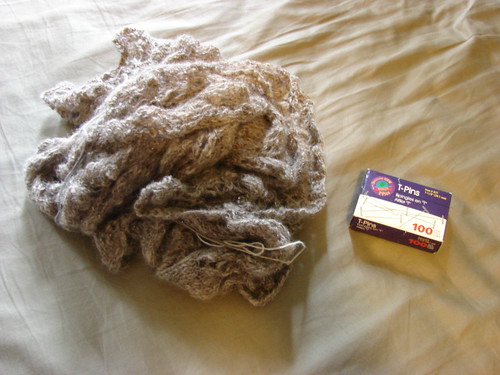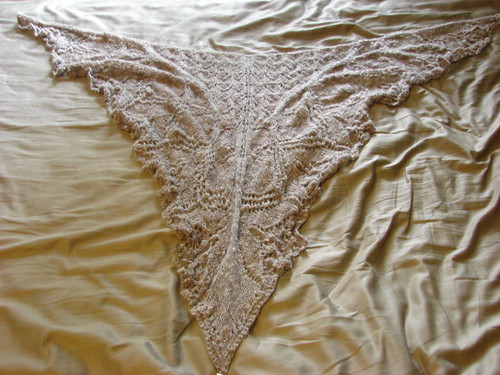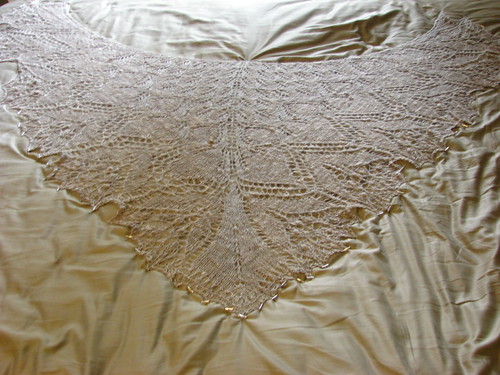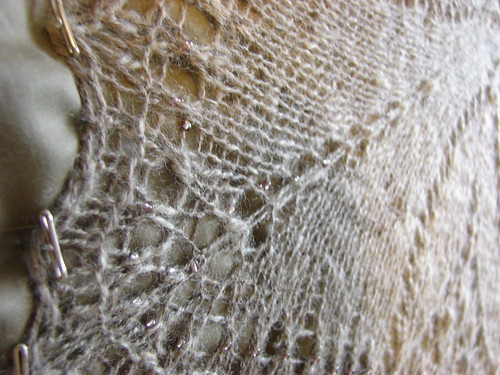
Time for blocking!
This is the part of lace knitting that makes or breaks the project, but no worries! You can always block again if you didn't get it right the first time.
I'm not a big fan of single-use tools. Apartment living makes you really think hard about purchases. While I think investing in a blocking board is a great idea, especially if you need them a lot, and blocking wires are helpful, you don't NEED them. I do most of my blocking on bath towels or on the bed.
The first thing I did was take a long length of scrap sock yarn that wasn't going to bleed all over the place. I used a darning needle to thread it through the top of the shawl, or whatever you want to be a straight line. Leave yourself some nice long ends.
Then I soak the entire shawl in hot water and Eucalan. I love that stuff- it smells great and you don't have to rinse. While you don't have to wash, I do. My knitting goes with me everywhere. By the time I've got a FO on my hands, chances are I have dropped said project and yarn on New York City Public Transit more times then I care to think back on. Everything I knit gets washed.
After 20 minutes of soak, I gently pick it up and squeeze out the excess water. I'll take this chance to yell at you if you wring out your woolies. NEVER WRING WOOL! Wool is super fragile when it is wet, and wringing it will damage and destroy it! Squeeze gently, and be patient.
Next, I put the wet object on a towel, roll it up and smoosh it down. You want the object damp but not dripping since you're going to be tying up your bed for the next few hours. You don't want to be spending days airing out your mattress as well.
Take it out of the towel and lay it out on the bed. You've previously stripped it of all blankets and pillows, and it has a clean sheet that you don't care too much about.
A word about pins: I use T pins that you can get at office supply stores. I use these when I'm seeming up a sweater as well. They are big and sturdy and they are easy to remove and easy to see so you won't get a rude awakening on the eve after blocking. They don't seem to rust either- you really don't want rust spots on your FO.
I start with the top edge of the shawl. That bit of yarn you threaded through before you soaked the object? Pull it tight and pin the top edge out. I usually tie it cleat-style with two pins. You don't want this to move around too much when you are pinning the rest of the shawl.
Once you have the top straight edge secured, find the bottom point of the shawl. Stretch it out and pin that down at the point. I stretched this pretty gently since it was laceweight handspun. You will need an entire psych team to talk you down if you ripped your shawl during blocking. When in doubt, a little bit less blocked is better then having a mess to deal with.

There! Almost done! Now you just have all the points to pin out. Usually, a good pattern will have specific blocking instructions. This one wanted each big leaf point blocked, plus the four smaller points around it, all marked by where you correctly placed a Nupp. I started at the bottom and (this is important) kept going back and forth to the left and right of the shawl to pin the points. Symmetry...kind of important on a lace shawl.
Since there are 12 points, and 5 pins for each point plus more for the top and the bottom, I used almost 70 pins.

For the first time, you get to really see your handywork.

Neat, huh? Nevermind the fact that I found a dropped stitch while I was doing this. It is fixed now. I'll never tell you where it is. You won't be able to find it.

I put the ceiling fan on and dragged in a second fan, just to improve my chances of having a bed to sleep in that night. It was pretty humid out that day, so I left the house for a few hours just so I wouldn't be tempted to futz with it or unpin it before it was dry.
And that's blocking for you.
No comments:
Post a Comment